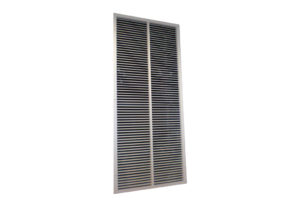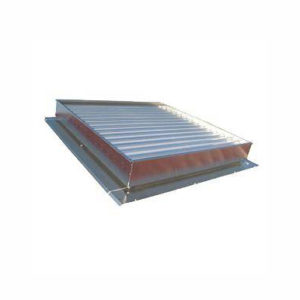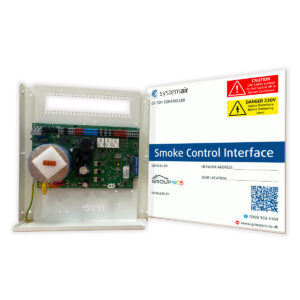In the second part of our series, we take a look at the most common areas of non-compliance and present recommended actions to mitigate risk. Moreover, we further discuss how to select compliant smoke control systems and look at the costs associated with each area. Our analysis is based on a typical 10-storey building with a single mechanical smoke shaft as a model.
Compliant smoke control systems by component
Typically, the average cost for the supply and installation of a mechanical smoke shaft system using certified products for a 10-storey building is in the region of £110,000. An example of the cost difference between compliant and non-compliant products for the common grey areas is outlined below together with recommended actions to reduce risk.
 Smoke Shaft Ventilators
Smoke Shaft Ventilators
The current version of the SCA Guide to smoke control in apartment buildings specifies that products should be multi-zone smoke control dampers CE marked to BS EN 12101 Part 8.
There are several low-cost approaches proposed for this application including fire doors with actuators bolted onto them and fire dampers with fail-safe mechanism removed and replaced with actuators. However, these products do not comply with a single harmonised standard. This means they are not CE/CA marked and therefore contravene the Construction Products Regulation.
Bottom line
The cost difference between a certified BS EN 12101:8 multi-zone smoke damper and an ad-hoc uncertified actuated fire door can be as much as £615.00.
The cost difference to the project would be in the region of £6,150.00.
Recommended Buyer Action
Obtain a Declaration of Performance to BS EN 12101-8.
 Natural Ventilators
Natural Ventilators
Typically used at the top of the stairwell and at the head of natural smoke shafts, these are suitable for both inlet and outlet according to the design of the system.
Where roof-mounted hinged single flap ventilators are used for smoke extract, a minimum opening angle of 140° is recommended. It is no longer acceptable to install an actuator onto an existing window or vent unless the combination of both window and actuator have been fully tested and a Declaration of Performance is provided by the manufacturer.
Bottom line
The cost-saving for using an untested window and actuator combination over a certified ventilator would be around £600.00.
Recommended Buyer Action
Obtain a declaration of performance to BS EN 12101:2.
 Control Panels
Control Panels
BS EN 12101 Smoke and heat control systems: Part 10 power supplies is harmonised under the Construction Products Regulation. All power supplies for smoke control systems shall be CE/CA marked to BS EN12101 part 10. There are many products on the market giving the illusion of compliance with this standard with the use of terms like “designed in accordance with”, but without test evidence or a declaration of performance to prove the certification, they are non-compliant and compromise on safety. Power supply units complying with EN54/4 fire alarm standard are also commonly used in this application. Each floor of a smoke shaft system will typically have a local power supply unit.
Bottom line
The installed cost difference for a certified BE EN12101:10 certified product over an untested unit is around £300.
The cost difference to the project £3,000.
Recommended Action
Obtain a declaration of performance to BS EN 12101:10 from your supplier.
Smoke extract fans with inverter control
In case you are using a fan and inverter combination, they must have been tested to EN12101-3 together. Alternatively, the inverter must be bypassed in fire mode and the fans run at full speed. Tested combinations of fan and inverter on the market are limited and they are at a price premium compared to low-cost alternatives.
Bottom line
For a typical system, the installed cost difference for a certified product would be around £1,200.00.
Recommended Action
In case the proposed system uses inverters to control fans, obtain written confirmation that the fan and inverter combination has been tested together to BS EN 12101:3.
Electrical wiring
Cables should comply with the following categories for fire survival in accordance with BS 8519 as appropriate for different applications:
- Category 1 (PH30/F30 minute survival time) – activation and monitoring only
- Category 2 (PH60/F60 minute survival time) – Means of escape systems
- Category 3 (PH120 + Annex B/F120 minute survival time) – Firefighting systems
Incorrect cable classifications can be a source of cost-cutting and the installed variation between category 1 and 2 is around £3/m and for category 2 and 3 as much as £5/m.
Bottom Line
All in all, cost variation for using the wrong cable classification could easily be in excess of £3,000.
Recommended Action
Obtain written confirmation that cable categories are in accordance with BS8519 and thoroughly check technical submissions.
Power distribution
For mechanical systems, the primary and secondary power cables should only come together in the fire-resisting enclosure or fire-resisting roof area housing the fan control panel through an automatic transfer switch (ATS) conforming to BS EN 60947-6. Due to the availability of safety and firefighting equipment being conditional to the occupation of the building, a bypass arrangement should be incorporated to enable the changeover device to be maintained without loss of service from the critical plant if a fire breaks out.
Bottom line
The use of non-tested ATS units is very common and the incorporation of a maintenance bypass is quite rare. All in all, the total cost premium for a certified ATS unit with a bypass facility is in the region of £2,000.00.
Recommended Action
Obtain a declaration of performance to BS EN 60947-6 and written confirmation that the ATS incorporates a maintenance bypass arrangement.
Ductwork
Any smoke control ducts should as a minimum be classified to BS EN 13501-4. Particularly, multi-compartment smoke control ducts shall be tested to EN1366-1 and the EN1366- 8. Single compartment smoke control ducts shall be tested to EN1366-9, to be safety compliant.
Bottom line
Overall, unclassified ductwork is often used for external sections as a cost-saving measure typically reducing the cost by £2,000.
Recommended Action
Obtain declaration of performance to BS EN 12101:7.
Professional Indemnity Insurance
Contractors were hit by spiralling PI insurance costs following the Grenfell tower tragedy. More than 70% of contractors said their PI insurance costs increased by at least 20%. Additionally, 22% said that the cost had more than doubled.
It has also been exposed that some insurers have included fire safety exclusions. Due to their nature, these exclusions pose significant risks to contractors, clients, and the public. To illustrate, an article featured by the Howden Group reveals one of the most onerous of these exclusions:
“This policy shall not indemnify the insured for any claim, circumstance, loss, liability, cost, expense or defence costs, or part thereof, arising in respect of or in any way related to or in connection with the fire safety of any building.”
Furthermore, there is evidence that some contractors within the fire industry are taking out PI insurance policies containing such clauses to reduce costs, which would effectively render them useless.
Bottom line
The cost of correct PI insurance can be as much as five times that of cover with fire safety exclusions.
Recommended action
In order to mitigate these risks, always check the policy wording and certificate of insurance from the vendor company to ensure they meet the policy requirements.
A summary of advice for compliant smoke control solutions
Based on the above figures, the potential maximum gross cost saving to the client for utilising non-compliant products is likely to be less than 0.003% or £30,000 on a £10m build cost, not taking into account the cost of tendering and the additional fees associated with the late design work. This potential initial saving must be weighed against the risk of the project being delayed and non-compliant systems being replaced, or worse – failing to operate when needed.
To conclude, specifiers and buyers have a responsibility to assess the suitability of proposals from vendors to reduce the occupant risks and stop exposing businesses to financial penalties. Most importantly, they must always:
- Always ask for a Declaration of Performance for all products supplied
- Always assess the competence of vendors and insist on third party certification as a minimum


